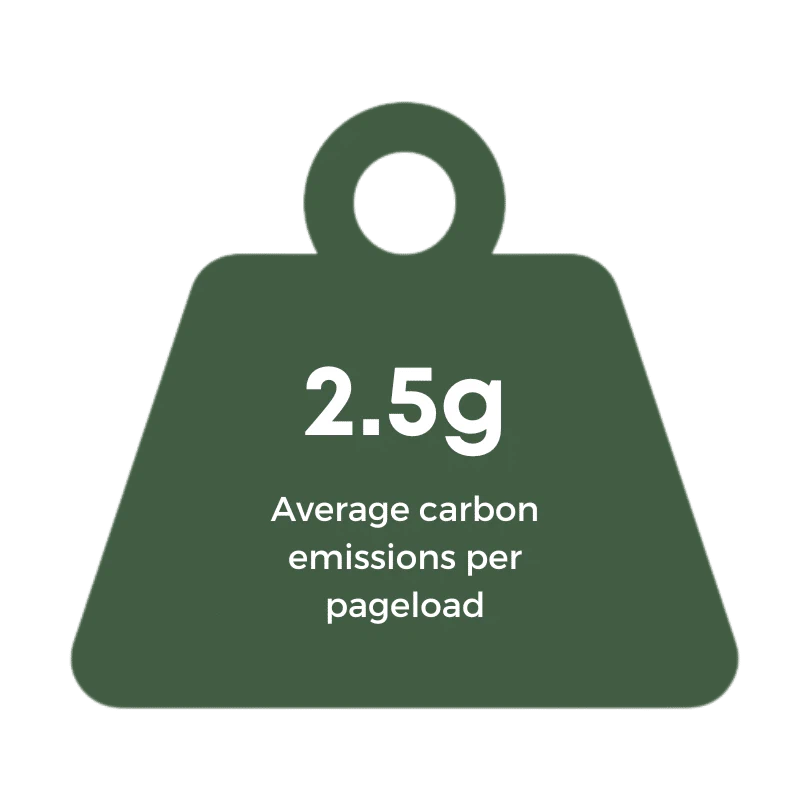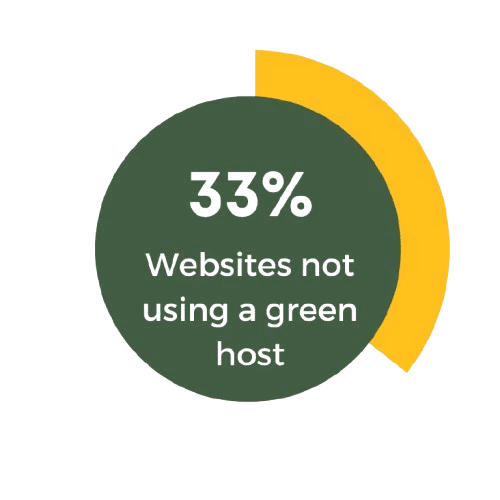Assessing the impact
of B-Corp
Websites:
Opportunities for Improvement


As companies increasingly recognise and work to reduce their environmental impact, the digital carbon footprints of websites have become an important but often overlooked area of environmental responsibility.
This study evaluates the sustainability of websites of B-Corp certified companies, with a focus on their carbon efficiency. By assessing their use of green hosting and calculating carbon emissions per page load, this study aims to highlight the environmental impact of these companies’ websites and encourage B-Corps to make reducing the environmental impact of their websites a priority.

Methodology Overview
We evaluated a 5% sample of B-Corp certified organisations with a headcount of 10 or more. These companies
operate in the UK, the US, or both. Using tools like Green Web Check and Ecograder by Mightybytes, we assessed
their websites sustainability. Green Web Check verifies whether websites use hosting powered by renewable
energy, while Ecograder estimates greenhouse gas emissions per page load and offers ways to improve your
score. The study focused on homepage performance as a representative sample.
Please note: The data from this study was correct as of August 8th 2024.
The Environmental Impact of Websites
Websites contribute to carbon emissions through the energy required to power servers and transfer data. Reducing these emissions is a key component of global environmental responsibility, especially as businesses become more reliant on digital platforms.
By making websites more carbon-efficient, companies can significantly reduce their environmental impact. As an added bonus, this often helps the websites convert better, whether that’s increased sign-ups, enquiries or sales.
B-Corp Commitment
B-Corps are committed to balancing profit with environmental and social responsibility, and as such, we believe their websites should reflect this ethos.
Currently, it is not a requirement for B-Corp certification to include carbon-efficient web hosting, despite the clear environmental benefits, although that is due to change. CA1 of the latest draft standards for B-Corps state that each company must measure its Greenhouse Gas (GHG) emissions annually, and that should include the emissions their website produces.
As Nick Mailer from Positive Internet Company notes, “B-Corps, by definition, can go beyond just looking for certifications here and think about these issues holistically. B-Corps are a self-selected group who have already identified they’re not afraid of zoomed-in details or zoomed-out wider scope.”
Given their mission to lead by example, B-Corps have an opportunity to lead by example and embrace greener digital practices.
Methodology
Website Hosting and Green Energy Use
We assessed whether each website was hosted on servers powered by green energy. Green Web Check helped us determine which companies used environmentally friendly hosting solutions, which is crucial for reducing carbon footprints.
We should caveat at this stage – some of these websites may be hosted using clean energy but aren’t yet verified via their Green Web Dataset, and, as a result, are shown as not using green energy.
Greenhouse Gas Emissions Estimates
Ecograder evaluates a website s greenhouse gas (GHG) emissions using CO2.js from The Green Web Foundation, factoring in web hosting provider data. It s worth noting that Ecograder is not yet using the latest version of CO2.js, which often produces lower emissions estimates.
Websites are scored out of 100 based on their performance lower scores indicate an under-optimised site and greater emissions.
Monthly greenhouse gas emissions were estimated by multiplying each site’s homepage score by its estimated monthly traffic, using Ahrefs data, and assuming an average of 2.6 page views per visitor. The SWD model used in CO2.js also factors in caching for new vs returning visitors for more accurate estimates.
Key Findings
Top 5 Most Efficient Websites
1. Go MAD Thinking
Despite not using green hosting at the time of the analysis, their website’s design efficiency helps keep emissions low. Since we conducted the study it would appear that they have now either switched to a green host, or the Green Web Check now recognises their host as using renewable energy. Either way, we approve.
2. Malouf Companies
Cloudflare’s green hosting and a simple design result in a highly efficient site. Malouf’s homepage had no unused code at the time of testing.
3. Above Green
Utilising Cloudflare and keeping emissions at just 0.34g per page load. Above Green’s UX scored 99% against Ecograder’s criteria.
4. Resilio Solutions
Just 0.28g of GHG emissions per page load, and a green host – Infomaniak – too. Quick improvements could still be made by removing unused code, which scored 50% on Ecograder’s test.
5. Lead Tech
Green hosting with Cloudflare and an efficient website design yield low emissions. Although there are several images and animations on their homepage, of the 30 images there was only 1 opportunity to optimise an image to improve page load time by up to 80 ms.
Highest Carbon Per Pageload
1. Shinebox
This site has significant room for improvement, with the highest emissions per page load and inefficient hosting practices. The former is due largely to the heavy use of video and animation on the homepage, which combined with the potential lack of green hosting, counteracts the excellent Ecograder score.
2. Zero
It’s important to note here that at the time of our analysis, Zero had a temporary one-page website. Zero are currently in the process of building a new website with a key focus on delivering a site with a low carbon footprint, which we definitely approve of.
3. MicroHabitat
This website has very low visibility, so its total emissions are very low despite its high emissions per pageload. However, the video hero banner added 29.42 MB of weight to the page, which we’d encourage MicroHabitat to reduce the size of, or replace with an image.
4. 6 Group
5. Fifty Fifty Post
Websites with the Most Opportunity
1. Oddbox
Large traffic volumes present an opportunity for significant reductions through optimisation. Despite a relatively strong Ecograder score, there are still opportunities to remove unused code and reduce the weight of their pages.
2. Softstar
While already using AWS green hosting, Softstar’s high estimated monthly traffic means if they could improve their rendering and caching further, they could still reduce their impact significantly.
3. Bambino Mio
Again, not a bad Ecograder score but there are huge opportunities for Bambino Mio to reduce their impact. Reducing page weight, removing duplicate modules in JavaScript bundles, and improving caching could drastically reduce emissions.
4. Brainiac Foods
Brainiac Foods’ site is hosted on Cloudflare’s green energy, but could further benefit from reduced image sizes and identifying elements that impede page rendering.
5. Moo Free Chocolates
An excellent Ecograder score could be further improved by reducing the number of server requests, properly sizing images and improving caching. This would lower Moo Free Chocolate’s website emissions further, given their high volume of estimated organic traffic.
Average Scores
& General Trends

The overall emissions of the 5% of websites we tested were approximately 255,780kg, or 255.6 tonnes, of carbon emissions per year.
From this we can estimate that the websites of all B-Corps that operate in the UK and US combined emit somewhere in the region of 5,000 tonnes of CO₂ per year.



Notably, 33% of the websites were not using green hosting. This is one of the simplest changes a company can make to reduce their website’s GHG emissions
How to reduce the emissions of your website
Move to a green web host
Transitioning to green web hosting can dramatically reduce emissions. Hosting providers like Cloudflare and Amazon Web Services offer renewable energy-powered servers, which can cut carbon footprints by 60% or more. We recommend The Positive Internet Company, who host the GrowRoom website.
Make your site more efficient
B-Corps can lower their website’s emissions through practical steps such as:
- Image Optimisation: Compress and reduce image sizes for faster load times. Use WebP and AVIF image formats where possible.
- Efficient Coding: Leverage efficient coding practice, such as removing unnecessary code, implementing lazy-loading caching, and shifting tasks to energy-saving systems where feasible. Incorporating regular code reviews—both automated and manual—alongside continual optimisation efforts helps prioritise efficiency at every stage of your website’s development.
- CDNs: Utilise Content Delivery Networks (CDNs) to serve content more efficiently and reduce load times.
Contact GrowRoom for further advice on reducing carbon emissions of your website, whilst improving your site’s conversion rate.
Monitor performance
We used Ecograder to capture a sample (homepage only) of each website’s performance at the time of testing. For long-term testing and improvement, we recommend using Digital Carbon Online’s excellent tool that continually assesses the carbon emissions of your entire website over time, as each user visits it.
Case Studies
Success Stories
- Malouf Companies: With a score of 88, Malouf Companies leverage Cloudflare’s green hosting and optimised design, resulting in lower emissions of just 0.28g per page load.
- Above Green: Achieving an Ecograder score of 87, they demonstrate that simple design and UX, combined with green hosting, can significantly reduce carbon emissions.
Lessons from Poor Performers
- Flowerbx: Despite high traffic, Flowerbx can reduce their 6.68g/page emissions by optimising images and compressing files, alongside migrating to green hosting.
- Thrift Plus: With a score of 43, switching to a green hosting provider and improving overall design could drastically lower their carbon output.
Conclusion
Our study highlights a wide range of performance among B-Corp websites. While some companies have embraced sustainable practices through green hosting and optimised design, others lag behind.
The average Ecograder score of 58% and the significant potential for carbon reduction underscore the importance of reducing the emissions of websites, with a huge opportunity for B-Corps to lead the way.
We encourage all B-Corp businesses to evaluate their digital sustainability and take steps to reduce their online carbon footprint.
GrowRoom offers expert services to help you transition to greener, more efficient digital practices, driving both business growth and environmental responsibility. Contact us today to take the first step to a more efficient website.
Contributors
We would like to thank the following people for their contributions to this study:
- Scott Stonham of Digital Carbon
- Tim Frick of Mighty Bytes and Ecograder
- Nick Mailer of The Positive Internet Company
FAQs
B-Corps are committed to balancing profit and purpose, and digital sustainability is a crucial part of reducing environmental impact in the modern, web-driven world.
CA1 of the latest draft standards for B-Corps state that each company, applying or re-certifying for BCorp status, will need to measure its Greenhouse Gas (GHG) emissions annually, and that should include the emissions their website produces.
You can use the Green Web Check tool to verify if your website is hosted on green energy servers.
- Make sure you are on a green host
- Optimise images
- Minimise the use of videos
- Use a CDN
- Implement efficient coding practices
Ecograder and Digital Carbon Online both use data from CO2.js and estimate emissions based on your website s hosting provider and efficiency metrics, including page load times and design factors. For a full description of the model used in CO2.js, see Estimating Digital Emissions.